How to Calculate the Size of an Inverter for Your Solar Power System

Choosing the right inverter size for your solar power system is crucial to ensure efficient energy conversion and optimal performance. The inverter is responsible for converting the DC (direct current) electricity generated by your solar panels into AC (alternating current) electricity that can be used by household appliances.
Here’s a guide to help you determine the appropriate inverter size for your needs.
1.Determine Your Power Needs
To calculate the size of the inverter, you first need to know your total power consumption. This involves identifying all the appliances and devices you plan to run on the solar system and their respective power ratings.
Steps:
- List all appliances and devices.
- Note the wattage of each appliance. This information is usually found on a label or in the user manual.
- Add up the wattages to get the total power consumption.
Example:
- Refrigerator: 200W
- Television: 150W
- Lights: 100W
- Laptop: 50W
- Total Power Consumption: 500W
2. Account for Peak Power Requirements
Some appliances require more power to start than to run. This is known as surge or peak power. Inverters must handle these spikes without shutting down.
Steps:
- Identify appliances with high starting power (e.g., refrigerators, air conditioners, pumps).
- Check their surge power ratings, which can be several times their running power.
- Ensure your inverter can handle the highest surge requirement.
Example:
- Refrigerator running power: 200W
- Refrigerator surge power: 600W
- Highest surge requirement: 600W
3. Calculate the Continuous Power Requirement
Continuous power refers to the total power consumption of all the devices running simultaneously. Ensure the inverter can handle this continuous load without overheating or shutting down.
Steps:
- Sum up the power ratings of all appliances you intend to run at the same time.
Example:
- Continuous power requirement: 500W (from step 1)
4. Add a Safety Margin
It’s wise to add a safety margin to account for any unexpected power demands and to ensure the inverter operates efficiently without being pushed to its limits.
Steps:
- Add 20-25% to the total continuous power requirement to determine the inverter size.
Example:
- Continuous power requirement: 500W
- Safety margin (25% of 500W): 125W
- Total inverter size: 500W + 125W = 625W
5.Consider Future Expansion
If you plan to add more appliances or increase your power consumption in the future, factor this into your calculations. It’s better to invest in a slightly larger inverter now than to replace it later.
Steps:
- Estimate potential future power needs.
- Add this to your current total power requirement.
Example:
- Future additional power: 100W
- Total inverter size: 625W + 100W = 725W
6. Select the Inverter Type
Inverters come in different types, including pure sine wave and modified sine wave inverters. Pure sine wave inverters are more efficient and suitable for sensitive electronics, while modified sine wave inverters are cheaper but less efficient.
Steps:
- Determine the type of inverter based on your appliances and budget.
- Choose pure sine wave inverters for sensitive devices like computers and medical equipment.
Related article: How to Size a Solar Power System
Conclusion
Calculating the right inverter size involves understanding your total power consumption, accounting for surge power, adding a safety margin, and considering future expansion. By following these steps, you can ensure that your solar power system runs efficiently and reliably.
If you’re unsure or need professional advice, don’t hesitate to reach out to a trusted solar energy provider like Voltmatic Energy Solutions. We can help you design and install the perfect solar power system tailored to your specific needs.
Phone: 0759493610
Email: info@voltmaticenergysolutions.co.ke
